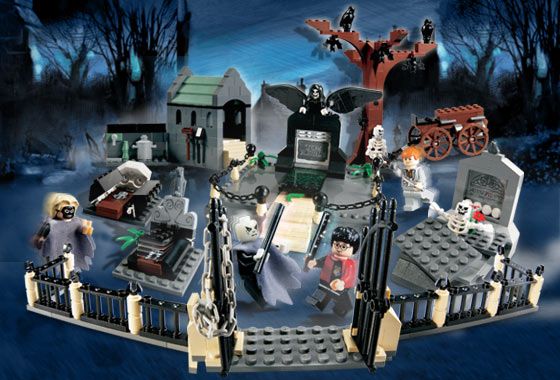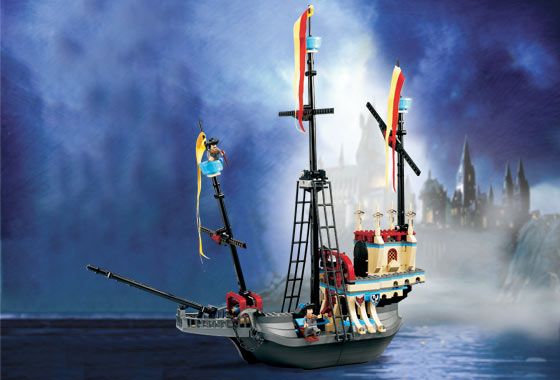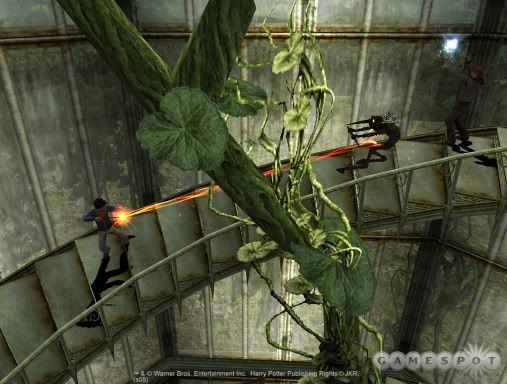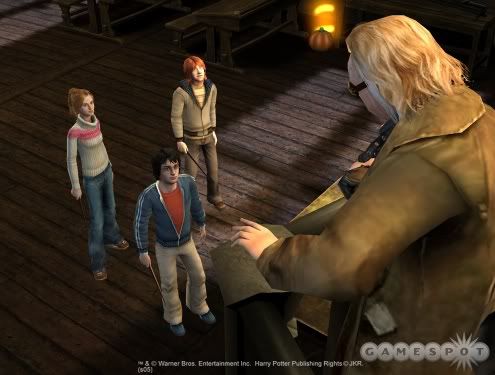Pre-Labor Day HARRY POTTER News
A very special delivery
DC Velocity has an interesting and detailed article regarding the logistics and planning behind the shipping and distribution of the sixth Harry Potter book.
With millions of muggles waiting for the latest Harry Potter volume to hit the bookstores (or their doorsteps), the people charged with its distribution relied not on magic, but on careful planning and painstaking execution.
THERE IS MAGIC IN LITERATURE, THE KIND OF magic that engages and entrances a reader and draws him or her into the characters' lives.
And in some books, like Harry Potter and the Half-Blood Prince, magic is deeply entwined in the plot's twists and turns as well.
Whether or not that explains the phenomenon that is Harry Potter, there's no denying that the series written by J.K. Rowling has resonated with readers around the world.
The publishing phenomenon continued this summer. On July 15, fans of Harry Potter flocked to bookstores around the nation to await the stroke of midnight, when the sixth book in the series would go on sale. Within 24 hours, 6.9 million copies of the book were in customers' hands.
While the books' appearance at the stroke of midnight may have seemed another bit of magic, something much more mundane was at work.
The responsibility for ensuring that stores had books to sell on July 16—but not before—required not magic, but careful planning and execution among its publisher, Scholastic, and Scholastic's printers and distribution partners. Given the project's scale—an initial printing of 10.8 million books—and the stipulation that every one of those books be kept under wraps until the release date, it's a story worth telling all its own.
It's all in the planning
The job of planning for the distribution of Harry Potter and the Half-Blood Prince fell to Andrew Yablin, who is vice president of global logistics for Scholastic. It was not his first experience with Harry. Yablin also headed up the logistics effort in 2003, when the fifth book in the series, Harry Potter and the Order of the Phoenix, was released.
Yablin credits meticulous planning, which began in January, for the smooth rollllout.
"I think the biggest key to our success, because we knew that this was going to be quite large, was the pre-planning that went into the whole thing," he says. "Plus I was fortunate enough to have the same team members both internally and from all the providers—it was a veteran team."
For Scholastic, the team included Yablin; Francine Colaneri, vice president of procurement, who oversaw manufacturing; and Ed Swart, direcr of operations for the Scholastic Trade Division.
"Watching a team that's been together before come together again and build on opportunities from the last time was an unbelievable experience," Yablin says. "For the three of us, it was quite an interesting challenge time the print-and-bind schedule to what sales needed and to what would work on the distribution and logistics side." EDITOR'S NOTE: PAUSING TO REMEMBER, JUST FOR A SEC, THAT WE ARE TALKING ABOUT A BOOK RELEASE, NOT THE INVASION OF NORMANDY.......
The carriers that would haul all those books also took part in the planning.
Terry Budimlija, who headed up the Harry Potter team for Yellow Transportation, reports that for Yellow, the process began in January.
"We had multiple discussions, conference calls and such to talk about the details, delivery dates and what Scholastic expected from Yellow. What we needed was information ahead of the product. Our detailed planning couldn't begin until we had information on shipments, consignees, delivery dates— information that allowed us to electronically sort into service centers and distribution centers."
Early on in the process, Yablin and his colleagues visited each of the eight U.S. binderies that would produce the book to ensure their shipping processes met Scholastic's strict requirements.
"The three of us went to every one of the binderies and put on a presentation on exactly how things were going to happen. Whether it was coming out of bindery A or bindery F, it had to be handled exactly the same way," Yablin says.
Scholastic went so far as to create a standard operating procedure that detailed everything from how pallets were to be shrink wrapped to the steps to be taken to ensure that shipments were handed off to the correct driver.
Yablin and his team also made site visits to the carriers' offices, traveling to both J.B. Hunt's headquarters in Lowell, Ark., and Yellow Transportation's headquarters in Overland Park, Kan., to work out in detail when and how the books would be moved. The team also remained in close communication with its other distribution partners, like Combined Express, a Pennsylvania-based third-party logistics service provider that managed all the appointments, deliveries and routing for Hunt and United Parcel Service (UPS).
Carriers get on board
Though Scholastic printed more copies this time than it did with the fifth volume (whose initial print run was a mere 6.8 million), its carrier base was smaller this time around. Yablin says he chose to use a single truckload provider to maximize the payload in his truckload shipments. Hunt ended up handling every one of the 10.8 million volumes in the first printing, including those that moved through Scholastic's own distribution center into the Yellow or UPS systems. That amounted to about 1,000 truckloads.
"The last time we weren't able to maximize payload because we had various providers with different tare weights on their vehicles,"Yablin says."This time we worked with Hunt specifically on getting the same equipment, and we were able to take some of our payload targets up to overcome some of the cost increases."
Those included diesel fuel costs that ran about a dollar a gallon higher than in June 2003, for the previous Harry Potter release, plus increases in base rates for all carriers. "We needed to maximize transportation capacity," Yablin notes. EDITOR'S NOTE: THIS GUY IS QUITE CANNY AT TURNING SOMETHING INHERENTLY EXCITING INTO SOMETHING RATHER BORING. (GOOD THING HE'S IN THE END OF THE BOOK BIZ HE IS AND NOT, SAY, AN AUTHOR).
Apparently he succeeded. "With Hunt's help, we averaged over 79,000 pounds on every truckload," Yablin reports. (The maximum allowed on most U.S. highways is 80,000 pounds.) EDITOR'S NOTE: OOO....ONLY 1000 POUNDS UNDER! NOW WE'RE TALKIN SUSPENSE! "That takes a lot of pre-planning, a lot of skill. We kept everything legal, but we kept it right at the legal max. Once we knew the book's specs and weight, we were able to max out the loads. I think we brought the payload up almost 8 percent on average from the last book to this book, which was really phenomenal."
Safe and secure
Hunt had the task of carrying all the books from the binderies and staging them for delivery to DCs run by major customers like Amazon.com and Barnes & Noble, as well as to Scholastic's DC in Jefferson City, Mo. But it also had another, more daunting responsibility: safeguarding those books between the time they were printed and the release date. The enormous number of books involved and the time it took to produce them increased that challenge. Scholastic's printers began producing the books in late May, a full month and a half before they went on sale, lengthening the period of exposure. EDITOR'S NOTE: SO WE COULD HAVE SNUCK INTO A WAREHOUSE SOMEWHERE AND READ THE BOOK IN LINE FOR ROTS!
The books could not linger for long within the binderies, which had little storage space. So the team had to come up with a different solution. Because the copies would move mostly in truckload quantities, the team decided to pre-position a lot of truckloads, using the trucks as rolling storage in Hunt's secure yards.
But the books didn't stay there for long. Two or three days after the presses started up, shipments of books began to move out. At that point, keeping those shipments secure while positioning them for delivery became the carrier's responsibility.
"We told them that security was job number one on this project," Yablin says. "There was an eight- to 10-week period where we had to keep this under wraps. We absolutely mandated that everything would stay on the trailers. I didn't want to take it off and put it in another facility."
This time around, the job was made easier by technological tools that weren't available in 2003.
"I think technology has come a long, long way in a short period of time," says Yablin.
Those technological tools included Qualcomm's OmniTracs satellite tracking system and its OmniExpress wireless fleet management system, which are installed on Hunt's tractors to help the carrier keep tabs on shipments in the yards or on the road.
Hunt also equips its trailers with the FleetView wireless trailer management system sold by Texas-based Terion, a business-to-business wireless communication company. That system, which provides trailer location and event status information, became an important tool in safeguarding shipments after they were loaded.
Yablin explains that Hunt programmed the system on each truck to indicate the route from the bindery plant to the destination yard, so that it would trigger an alarm if the truck strayed off course. But even after the trailers reached their destination, the Terion system remained activated.
"Once a trailer was dropped in the secure yard, there was a geo-fence put around it," Yablin says. That meant the Terion system would send an alert if a trailer moved as little as 10 feet, he explains. "That was a tremendous advance from where we were just two years ago."
Over and out
Another of Hunt's responsibilities was to move truckloads of the Harry Potter book from the binderies to the Scholastic distribution center in Jefferson City, Mo. There, the books were staged for shipment via Yellow Transportation or UPS.
"We tried to make that process as close to cross-docking as we could," Yablin says. "We had our own procedures in the facility to keep the books out of the commingled storage rack. But we definitely tried to time it so that as soon as a Hunt truck arrived, the cargo was quickly loaded onto another vehicle and sent back out."
Much of that activity took place late in the process. For instance, Yellow collected the 750,000 books it would handle in some 2,000 shipments in late June. Those shipments, almost all carton pick orders, were scheduled based on the transit times Yellow needed to deliver books on Thursday, July 14, two days before they went on sale.
Though it handled less total volume than Hunt did, Yellow found that its job still presented plenty of challenges. The carrier had scheduled deliveries in the 48 contiguous states, plus Alaska, Hawaii and Puerto Rico.
Yellow was essentially responsible for two waves of deliveries: the first to small distributors or resellers that then shipped the books to other customers, and the second to small booksellers, drug stores and small retailers. The bulk of those deliveries were executed on Thursday, July 14, with a handful on Friday. Some shipments were as small as half a dozen cartons.
"Every single delivery was pre-positioned out to the destination terminals by Wednesday night. It all happened on Thursday, and we were able to move everything by road. We did not use any air," Yablin says. "By following their lead in getting products to the outer islands, Hawaii and up to Alaska, we released on time to minimize cost and keep the loads secure but also get them in position. In a lot of cases, we were able to load LTL direct to densely populated areas like Los Angeles and Boston and New York. We were able to load those in Missouri so that we wouldn't have to open the trailers until the delivery day. They were actually route loaded, so that we didn't have to touch it. We reduced our security risks significantly by eliminating the need to go through any of their DCs."
It helped that Yellow was able to determine how its trucks would be loaded well in advance of the books' release date, says Budimlija.
"Once we had a spreadsheet that had all the information, we were able to lay that on top of our network and put together a plan for loading trailers with the highest level of security we could. We were able to load 95 percent of the shipments to destination service centers or destination DCs. That minimized handling."
Most of Yellow's work took place on the weekend before the book's release, with shipments timed to reach destination terminals on Wednesday for the Thursday deliveries. Shipments to more distant locations, like Hawaii, Alaska and Puerto Rico, had moved earlier in the month.
Part and parcel
Along with Hunt and Yellow, the third carrier that participated in Scholastic's big rollout was UPS. Yablin says that although UPS played a relatively small role in the process, it was nonetheless a crucial player. The average order size was larger this time than for the 2003 release, he explains, so economics dictated that a larger share of shipments would move via LTL than by parcel delivery.
"But it was still critical to have the small-package service provider," he says.
For Scholastic, UPS handled shipments to some of the smallest retailers, as well as residential deliveries for books ordered directly from Scholastic, about 1,300 deliveries for a total of 16,000 books.
Both Yellow and UPS had a team working in the Scholastic DC for several days.
"We had their teams on the ground verifying count and address and order," reports Yablin. "We shipped carrier load and count: We did not want any problems with the count because of the security issues that would arise if something showed up at its destination short. We wanted to make sure the carrier was absolutely 100-percent responsible."
the end of the journey
Scholastic's logistics staff undoubtedly heaved a huge sigh of relief once all the copies of Harry Potter and the Half-Blood Prince had been delivered safely into their customers' hands. But that was by no means the end of the journey for many of those books. Once Scholastic's job was over, the millions of copies delivered to customers' DCs or fulfillment centers still had to be shipped out to retail stores or for residential deliveries.
Amazon.com, for example, says it received more than 1.5 million advance orders for the book, all of which had to be delivered to customers as soon as possible after the hour of release.
Amazon worked with UPS and the U.S. Postal Service to deliver hundreds of thousands of copies of the book to buyers on Saturday, July 16. (Amazon also made deliveries of the book to customers in the United Kingdom, Canada, Germany and Japan.)
Both Amazon and Barnes & Noble chose UPS to deliver a large share of their books, says Andrew Yablin, Scholastic's vice president of global logistics.
"Although we weren't paying the freight for those shipments, we did work diligently with Amazon and Barnes & Noble and UPS to make sure security measures were in place."
The process was more complicated than it might appear, says Steve Holmes, a spokesman for UPS.
"We had to create individual plans for Scholastic, Amazon and Barnes & Noble," he reports. "We needed to make sure we had the assets in place and we had to do a good bit of planning on security.
UPS also worked closely with the U.S. Postal Service for the residential deliveries on Saturday. UPS delivered books to post offices around the country on Friday for delivery the next day—a process that required a great deal of communication. Among other things, the postal service provided UPS drivers with letters explaining the plan in case of any confusion at local post offices. The carriers also came up with a contingency plan for UPS drivers to deliver any packages refused by a post office directly to the recipient.
Other carriers played a role in the book's last-mile distribution as well.
For example, Con-Way Transportation handled 4,000 LTL shipments of the book for Levy Home Entertainment, the book distribution arm of Chas. Levy Co. Levy Home Entertainment serves as a supplier to a number of large retail chains, including Best Buy, K-Mart, Meijer, Shopko, Stop & Shop, Target and Wal-Mart. Like Hunt, Yellow and UPS, Con-Way had to come up with ways to accommodate the need for tight security. For example, Con-Way says it had to arrange for shipments stored in its DCs in Hillside, Ill.; Salem, Va.; and Clearfield, Utah, to be held in secure, locked facilities prior to their release for final delivery. EDITOR'S NOTE: I DON'T KNOW.....I DIDN'T THINK THE DELIVERY AND SECURITY PROCESS WOULD BE AS INTERESTING AS THE BOOK ITSELF, BUT I STILL SORT OF FIGURED IT FOR A BIT OF PIZZAZZ. (BUT SINCE I HAD TO SUFFER THRU READING THIS ARTICLE, I DECIDED TO SHARE THE DISAPPOINTMENT. AND NOW, I ACTUALLY FEEL A BIT BETTER, KNOWING WE'VE ALL SUFFERED TOGETHER).
Dutch HBP cover released
Depicting a stairway with spells flying on the Dutch publishing site.

EDITOR'S NOTE: THESE FOREIGN COVERS ARE REALLY NIFTY! (I DON'T REMEMBER SEEING SO MUCH VARIANCE IN COVER ART WHEN GOF OR OOTP CAME OUT).
Four new GOF LEGOs released
Four new LEGOs for the Goblet of Fire movie have been added to Lego.com's online store.
They include:
Rescue from the Merpeople

Graveyard Duel

EDITOR'S NOTE: ODD DICHOTOMY....A HORRIFYING, TERRIFYING SCENE AS ENACTED BY CUTESYWOOTSEY WIDDLE LEGOS. (DISTURBING, ACTUALLY).
Harry and the Hungarian Hortail

and The Durmstrang Ship

EDITOR'S NOTE: AND WHEN WE'RE THRU PLAYING WITH OUR CREEPY/CUTE LEGOS, WE CAN IMMERSE OURSELVES IN THE GOF VIDEO GAME!:
Harry Potter and the Goblet of Fire Hands-On
Official Trailer
http://www.gamespot.com/ps2/action/harrypotterandthegobletoffire/preview_6132417.html
It's been interesting to watch the evolution of the Harry Potter series over the course of its six volumes, from a fairly lighthearted kids' tale to a much darker story that's drawn in millions of adults as well.
This tonal shift has been especially evident in the Harry Potter films--and, of course, the games based upon those films.
The latest game in the series is the forthcoming Harry Potter and the Goblet of Fire, which chronicles Harry's accidental entry into the prestigious--but wildly dangerous--Tri-Wizard Tournament, as well as the resulting events that have enormous repercussions for the entire wizarding world. We got a new look at the console version of the game to see how well it will represent the beloved story of the book and film.
Much like EA's other big-huge-fantasy-movie game series, The Lord of the Rings, Goblet of Fire will let you grab two friends and play through most of the game cooperatively.
In past games, Harry, Ron, and Hermione actually played differently, but this time, the difference between the characters will be cosmetic only, so you won't be confined to one character depending on which scenario you're in.
You've got two basic spell buttons--jinx and charm--and these will invoke different spells in different levels, depending on the requirements of your current predicament.
For instance, we got a new look at the Death Eater attack at the Quidditch World Championship, which will serve as the game's opening level, in which the three friends try to escape a magical assault by the followers of Lord Voldemort, not to mention a host of nasty creatures like the doglike dugbog.
Our charm here was wingardium leviosa, which devotees of the Potter books will know allows the user to levitate objects--in this case, large rocks that we could hurl at enemies. You'll also have to use your spells to solve some basic puzzles, such as using wingardium leviosa , along with the other two characters (controlled by other players or the artificial intelligence), to move a massive boulder and clear a path.

Levels like Herbology will encourage you to go back and look for more secrets as you become more powerful
Only a few sections of the game will constrain your choice of character to Harry; naturally, those are the Tri-Wizard levels, in which only Harry takes part.
The first challenge has Harry speeding around on his broom in a frantic race all over Hogwarts' grounds (and over the castle itself) to beat a dragon. We also got to see the second Tri-Wizard level, which sends Harry to the bottom of a lake to rescue his trapped friends, while he fights off mer-people and grindylows. Both of these levels are different from the regular cooperative ones, not only because you'll play just as Harry, but also because they're a bit more linear, requiring you to travel along a set path, avoiding obstacles and fighting enemies until you reach your objective.
EA isn't ready to show off the third Tri-Wizard level, which will naturally be based on the dangerous hedge maze from the book and film, though we're interested to see how it turns out based on what we've seen so far.
We also got to see parts of two new levels based on the herbology and defense against the dark arts classes at Hogwarts.
Both of these are similar to the Forest Campsite level, in that they're full of obstacles that you'll often need multiple characters to bypass.
In the Herbology level, the three friends had access to the herbivicus spell, which could be used to make plants grow very quickly and in strange ways, which was useful for opening up new areas.
In another instance, the spell was useful for opening up seed pods that would attract some nasty vampyr mosps (which are giant beelike creatures with massive stingers, natch).
The Defense Against the Dark Arts level takes place high up in the castle, and features such puzzles as large drawbridges that you'll have to use the carpe retractum spell to lower.
You'll be able to revisit these and other levels as you progress through the game. The more powerful your characters become, the more areas you'll have access to, and there will be hidden collectibles to discover that should encourage players to go back and explore further.
In fact, though the spells you'll have access to will depend on which level you're playing, you'll be able to power up each character independently by collecting magic beans throughout the levels.
As you finish each level, you'll increase the attributes of a certain spell, which will give it longer range or more power. You'll also have access to a sort of smart bomb that you can activate by collecting enough of the right bean in a given level.

The fourth-year students will take defense against the dark arts lessons from none other than famous auror Mad-Eye Moody.
EDITOR'S NOTE: THE LIKENESSES TO THE ACTORS ARE REALLY REALLY COOL, HUH?!
The EA team is focusing more intently on nailing the look of the film in the Goblet of Fire game.
Whereas the previous game, Prisoner of Azkaban, had a style reminiscent of the film but with its own elements added, this time around the artists are striving to make the characters look as close to their real-life counterparts as possible. EDITOR'S NOTE: AND I THINK THEY REALLY SUCCEEDED!
The artists have also worked with the film's production design to create a Hogwarts and a Tri-Wizard Tournament that are both highly evocative of the forthcoming movie.
We'll find out how successful they've been when Harry Potter and the Goblet of Fire ships on the PS2, Xbox, GameCube, and PC in November. Stay tuned for more.
DC Velocity has an interesting and detailed article regarding the logistics and planning behind the shipping and distribution of the sixth Harry Potter book.
With millions of muggles waiting for the latest Harry Potter volume to hit the bookstores (or their doorsteps), the people charged with its distribution relied not on magic, but on careful planning and painstaking execution.
THERE IS MAGIC IN LITERATURE, THE KIND OF magic that engages and entrances a reader and draws him or her into the characters' lives.
And in some books, like Harry Potter and the Half-Blood Prince, magic is deeply entwined in the plot's twists and turns as well.
Whether or not that explains the phenomenon that is Harry Potter, there's no denying that the series written by J.K. Rowling has resonated with readers around the world.
The publishing phenomenon continued this summer. On July 15, fans of Harry Potter flocked to bookstores around the nation to await the stroke of midnight, when the sixth book in the series would go on sale. Within 24 hours, 6.9 million copies of the book were in customers' hands.
While the books' appearance at the stroke of midnight may have seemed another bit of magic, something much more mundane was at work.
The responsibility for ensuring that stores had books to sell on July 16—but not before—required not magic, but careful planning and execution among its publisher, Scholastic, and Scholastic's printers and distribution partners. Given the project's scale—an initial printing of 10.8 million books—and the stipulation that every one of those books be kept under wraps until the release date, it's a story worth telling all its own.
It's all in the planning
The job of planning for the distribution of Harry Potter and the Half-Blood Prince fell to Andrew Yablin, who is vice president of global logistics for Scholastic. It was not his first experience with Harry. Yablin also headed up the logistics effort in 2003, when the fifth book in the series, Harry Potter and the Order of the Phoenix, was released.
Yablin credits meticulous planning, which began in January, for the smooth rollllout.
"I think the biggest key to our success, because we knew that this was going to be quite large, was the pre-planning that went into the whole thing," he says. "Plus I was fortunate enough to have the same team members both internally and from all the providers—it was a veteran team."
For Scholastic, the team included Yablin; Francine Colaneri, vice president of procurement, who oversaw manufacturing; and Ed Swart, direcr of operations for the Scholastic Trade Division.
"Watching a team that's been together before come together again and build on opportunities from the last time was an unbelievable experience," Yablin says. "For the three of us, it was quite an interesting challenge time the print-and-bind schedule to what sales needed and to what would work on the distribution and logistics side." EDITOR'S NOTE: PAUSING TO REMEMBER, JUST FOR A SEC, THAT WE ARE TALKING ABOUT A BOOK RELEASE, NOT THE INVASION OF NORMANDY.......
The carriers that would haul all those books also took part in the planning.
Terry Budimlija, who headed up the Harry Potter team for Yellow Transportation, reports that for Yellow, the process began in January.
"We had multiple discussions, conference calls and such to talk about the details, delivery dates and what Scholastic expected from Yellow. What we needed was information ahead of the product. Our detailed planning couldn't begin until we had information on shipments, consignees, delivery dates— information that allowed us to electronically sort into service centers and distribution centers."
Early on in the process, Yablin and his colleagues visited each of the eight U.S. binderies that would produce the book to ensure their shipping processes met Scholastic's strict requirements.
"The three of us went to every one of the binderies and put on a presentation on exactly how things were going to happen. Whether it was coming out of bindery A or bindery F, it had to be handled exactly the same way," Yablin says.
Scholastic went so far as to create a standard operating procedure that detailed everything from how pallets were to be shrink wrapped to the steps to be taken to ensure that shipments were handed off to the correct driver.
Yablin and his team also made site visits to the carriers' offices, traveling to both J.B. Hunt's headquarters in Lowell, Ark., and Yellow Transportation's headquarters in Overland Park, Kan., to work out in detail when and how the books would be moved. The team also remained in close communication with its other distribution partners, like Combined Express, a Pennsylvania-based third-party logistics service provider that managed all the appointments, deliveries and routing for Hunt and United Parcel Service (UPS).
Carriers get on board
Though Scholastic printed more copies this time than it did with the fifth volume (whose initial print run was a mere 6.8 million), its carrier base was smaller this time around. Yablin says he chose to use a single truckload provider to maximize the payload in his truckload shipments. Hunt ended up handling every one of the 10.8 million volumes in the first printing, including those that moved through Scholastic's own distribution center into the Yellow or UPS systems. That amounted to about 1,000 truckloads.
"The last time we weren't able to maximize payload because we had various providers with different tare weights on their vehicles,"Yablin says."This time we worked with Hunt specifically on getting the same equipment, and we were able to take some of our payload targets up to overcome some of the cost increases."
Those included diesel fuel costs that ran about a dollar a gallon higher than in June 2003, for the previous Harry Potter release, plus increases in base rates for all carriers. "We needed to maximize transportation capacity," Yablin notes. EDITOR'S NOTE: THIS GUY IS QUITE CANNY AT TURNING SOMETHING INHERENTLY EXCITING INTO SOMETHING RATHER BORING. (GOOD THING HE'S IN THE END OF THE BOOK BIZ HE IS AND NOT, SAY, AN AUTHOR).
Apparently he succeeded. "With Hunt's help, we averaged over 79,000 pounds on every truckload," Yablin reports. (The maximum allowed on most U.S. highways is 80,000 pounds.) EDITOR'S NOTE: OOO....ONLY 1000 POUNDS UNDER! NOW WE'RE TALKIN SUSPENSE! "That takes a lot of pre-planning, a lot of skill. We kept everything legal, but we kept it right at the legal max. Once we knew the book's specs and weight, we were able to max out the loads. I think we brought the payload up almost 8 percent on average from the last book to this book, which was really phenomenal."
Safe and secure
Hunt had the task of carrying all the books from the binderies and staging them for delivery to DCs run by major customers like Amazon.com and Barnes & Noble, as well as to Scholastic's DC in Jefferson City, Mo. But it also had another, more daunting responsibility: safeguarding those books between the time they were printed and the release date. The enormous number of books involved and the time it took to produce them increased that challenge. Scholastic's printers began producing the books in late May, a full month and a half before they went on sale, lengthening the period of exposure. EDITOR'S NOTE: SO WE COULD HAVE SNUCK INTO A WAREHOUSE SOMEWHERE AND READ THE BOOK IN LINE FOR ROTS!
The books could not linger for long within the binderies, which had little storage space. So the team had to come up with a different solution. Because the copies would move mostly in truckload quantities, the team decided to pre-position a lot of truckloads, using the trucks as rolling storage in Hunt's secure yards.
But the books didn't stay there for long. Two or three days after the presses started up, shipments of books began to move out. At that point, keeping those shipments secure while positioning them for delivery became the carrier's responsibility.
"We told them that security was job number one on this project," Yablin says. "There was an eight- to 10-week period where we had to keep this under wraps. We absolutely mandated that everything would stay on the trailers. I didn't want to take it off and put it in another facility."
This time around, the job was made easier by technological tools that weren't available in 2003.
"I think technology has come a long, long way in a short period of time," says Yablin.
Those technological tools included Qualcomm's OmniTracs satellite tracking system and its OmniExpress wireless fleet management system, which are installed on Hunt's tractors to help the carrier keep tabs on shipments in the yards or on the road.
Hunt also equips its trailers with the FleetView wireless trailer management system sold by Texas-based Terion, a business-to-business wireless communication company. That system, which provides trailer location and event status information, became an important tool in safeguarding shipments after they were loaded.
Yablin explains that Hunt programmed the system on each truck to indicate the route from the bindery plant to the destination yard, so that it would trigger an alarm if the truck strayed off course. But even after the trailers reached their destination, the Terion system remained activated.
"Once a trailer was dropped in the secure yard, there was a geo-fence put around it," Yablin says. That meant the Terion system would send an alert if a trailer moved as little as 10 feet, he explains. "That was a tremendous advance from where we were just two years ago."
Over and out
Another of Hunt's responsibilities was to move truckloads of the Harry Potter book from the binderies to the Scholastic distribution center in Jefferson City, Mo. There, the books were staged for shipment via Yellow Transportation or UPS.
"We tried to make that process as close to cross-docking as we could," Yablin says. "We had our own procedures in the facility to keep the books out of the commingled storage rack. But we definitely tried to time it so that as soon as a Hunt truck arrived, the cargo was quickly loaded onto another vehicle and sent back out."
Much of that activity took place late in the process. For instance, Yellow collected the 750,000 books it would handle in some 2,000 shipments in late June. Those shipments, almost all carton pick orders, were scheduled based on the transit times Yellow needed to deliver books on Thursday, July 14, two days before they went on sale.
Though it handled less total volume than Hunt did, Yellow found that its job still presented plenty of challenges. The carrier had scheduled deliveries in the 48 contiguous states, plus Alaska, Hawaii and Puerto Rico.
Yellow was essentially responsible for two waves of deliveries: the first to small distributors or resellers that then shipped the books to other customers, and the second to small booksellers, drug stores and small retailers. The bulk of those deliveries were executed on Thursday, July 14, with a handful on Friday. Some shipments were as small as half a dozen cartons.
"Every single delivery was pre-positioned out to the destination terminals by Wednesday night. It all happened on Thursday, and we were able to move everything by road. We did not use any air," Yablin says. "By following their lead in getting products to the outer islands, Hawaii and up to Alaska, we released on time to minimize cost and keep the loads secure but also get them in position. In a lot of cases, we were able to load LTL direct to densely populated areas like Los Angeles and Boston and New York. We were able to load those in Missouri so that we wouldn't have to open the trailers until the delivery day. They were actually route loaded, so that we didn't have to touch it. We reduced our security risks significantly by eliminating the need to go through any of their DCs."
It helped that Yellow was able to determine how its trucks would be loaded well in advance of the books' release date, says Budimlija.
"Once we had a spreadsheet that had all the information, we were able to lay that on top of our network and put together a plan for loading trailers with the highest level of security we could. We were able to load 95 percent of the shipments to destination service centers or destination DCs. That minimized handling."
Most of Yellow's work took place on the weekend before the book's release, with shipments timed to reach destination terminals on Wednesday for the Thursday deliveries. Shipments to more distant locations, like Hawaii, Alaska and Puerto Rico, had moved earlier in the month.
Part and parcel
Along with Hunt and Yellow, the third carrier that participated in Scholastic's big rollout was UPS. Yablin says that although UPS played a relatively small role in the process, it was nonetheless a crucial player. The average order size was larger this time than for the 2003 release, he explains, so economics dictated that a larger share of shipments would move via LTL than by parcel delivery.
"But it was still critical to have the small-package service provider," he says.
For Scholastic, UPS handled shipments to some of the smallest retailers, as well as residential deliveries for books ordered directly from Scholastic, about 1,300 deliveries for a total of 16,000 books.
Both Yellow and UPS had a team working in the Scholastic DC for several days.
"We had their teams on the ground verifying count and address and order," reports Yablin. "We shipped carrier load and count: We did not want any problems with the count because of the security issues that would arise if something showed up at its destination short. We wanted to make sure the carrier was absolutely 100-percent responsible."
the end of the journey
Scholastic's logistics staff undoubtedly heaved a huge sigh of relief once all the copies of Harry Potter and the Half-Blood Prince had been delivered safely into their customers' hands. But that was by no means the end of the journey for many of those books. Once Scholastic's job was over, the millions of copies delivered to customers' DCs or fulfillment centers still had to be shipped out to retail stores or for residential deliveries.
Amazon.com, for example, says it received more than 1.5 million advance orders for the book, all of which had to be delivered to customers as soon as possible after the hour of release.
Amazon worked with UPS and the U.S. Postal Service to deliver hundreds of thousands of copies of the book to buyers on Saturday, July 16. (Amazon also made deliveries of the book to customers in the United Kingdom, Canada, Germany and Japan.)
Both Amazon and Barnes & Noble chose UPS to deliver a large share of their books, says Andrew Yablin, Scholastic's vice president of global logistics.
"Although we weren't paying the freight for those shipments, we did work diligently with Amazon and Barnes & Noble and UPS to make sure security measures were in place."
The process was more complicated than it might appear, says Steve Holmes, a spokesman for UPS.
"We had to create individual plans for Scholastic, Amazon and Barnes & Noble," he reports. "We needed to make sure we had the assets in place and we had to do a good bit of planning on security.
UPS also worked closely with the U.S. Postal Service for the residential deliveries on Saturday. UPS delivered books to post offices around the country on Friday for delivery the next day—a process that required a great deal of communication. Among other things, the postal service provided UPS drivers with letters explaining the plan in case of any confusion at local post offices. The carriers also came up with a contingency plan for UPS drivers to deliver any packages refused by a post office directly to the recipient.
Other carriers played a role in the book's last-mile distribution as well.
For example, Con-Way Transportation handled 4,000 LTL shipments of the book for Levy Home Entertainment, the book distribution arm of Chas. Levy Co. Levy Home Entertainment serves as a supplier to a number of large retail chains, including Best Buy, K-Mart, Meijer, Shopko, Stop & Shop, Target and Wal-Mart. Like Hunt, Yellow and UPS, Con-Way had to come up with ways to accommodate the need for tight security. For example, Con-Way says it had to arrange for shipments stored in its DCs in Hillside, Ill.; Salem, Va.; and Clearfield, Utah, to be held in secure, locked facilities prior to their release for final delivery. EDITOR'S NOTE: I DON'T KNOW.....I DIDN'T THINK THE DELIVERY AND SECURITY PROCESS WOULD BE AS INTERESTING AS THE BOOK ITSELF, BUT I STILL SORT OF FIGURED IT FOR A BIT OF PIZZAZZ. (BUT SINCE I HAD TO SUFFER THRU READING THIS ARTICLE, I DECIDED TO SHARE THE DISAPPOINTMENT. AND NOW, I ACTUALLY FEEL A BIT BETTER, KNOWING WE'VE ALL SUFFERED TOGETHER).
Dutch HBP cover released
Depicting a stairway with spells flying on the Dutch publishing site.

EDITOR'S NOTE: THESE FOREIGN COVERS ARE REALLY NIFTY! (I DON'T REMEMBER SEEING SO MUCH VARIANCE IN COVER ART WHEN GOF OR OOTP CAME OUT).
Four new GOF LEGOs released
Four new LEGOs for the Goblet of Fire movie have been added to Lego.com's online store.
They include:
Rescue from the Merpeople

Graveyard Duel

EDITOR'S NOTE: ODD DICHOTOMY....A HORRIFYING, TERRIFYING SCENE AS ENACTED BY CUTESYWOOTSEY WIDDLE LEGOS. (DISTURBING, ACTUALLY).
Harry and the Hungarian Hortail

and The Durmstrang Ship

EDITOR'S NOTE: AND WHEN WE'RE THRU PLAYING WITH OUR CREEPY/CUTE LEGOS, WE CAN IMMERSE OURSELVES IN THE GOF VIDEO GAME!:
Harry Potter and the Goblet of Fire Hands-On
Official Trailer
http://www.gamespot.com/ps2/action/harrypotterandthegobletoffire/preview_6132417.html
It's been interesting to watch the evolution of the Harry Potter series over the course of its six volumes, from a fairly lighthearted kids' tale to a much darker story that's drawn in millions of adults as well.
This tonal shift has been especially evident in the Harry Potter films--and, of course, the games based upon those films.
The latest game in the series is the forthcoming Harry Potter and the Goblet of Fire, which chronicles Harry's accidental entry into the prestigious--but wildly dangerous--Tri-Wizard Tournament, as well as the resulting events that have enormous repercussions for the entire wizarding world. We got a new look at the console version of the game to see how well it will represent the beloved story of the book and film.
Much like EA's other big-huge-fantasy-movie game series, The Lord of the Rings, Goblet of Fire will let you grab two friends and play through most of the game cooperatively.
In past games, Harry, Ron, and Hermione actually played differently, but this time, the difference between the characters will be cosmetic only, so you won't be confined to one character depending on which scenario you're in.
You've got two basic spell buttons--jinx and charm--and these will invoke different spells in different levels, depending on the requirements of your current predicament.
For instance, we got a new look at the Death Eater attack at the Quidditch World Championship, which will serve as the game's opening level, in which the three friends try to escape a magical assault by the followers of Lord Voldemort, not to mention a host of nasty creatures like the doglike dugbog.
Our charm here was wingardium leviosa, which devotees of the Potter books will know allows the user to levitate objects--in this case, large rocks that we could hurl at enemies. You'll also have to use your spells to solve some basic puzzles, such as using wingardium leviosa , along with the other two characters (controlled by other players or the artificial intelligence), to move a massive boulder and clear a path.

Levels like Herbology will encourage you to go back and look for more secrets as you become more powerful
Only a few sections of the game will constrain your choice of character to Harry; naturally, those are the Tri-Wizard levels, in which only Harry takes part.
The first challenge has Harry speeding around on his broom in a frantic race all over Hogwarts' grounds (and over the castle itself) to beat a dragon. We also got to see the second Tri-Wizard level, which sends Harry to the bottom of a lake to rescue his trapped friends, while he fights off mer-people and grindylows. Both of these levels are different from the regular cooperative ones, not only because you'll play just as Harry, but also because they're a bit more linear, requiring you to travel along a set path, avoiding obstacles and fighting enemies until you reach your objective.
EA isn't ready to show off the third Tri-Wizard level, which will naturally be based on the dangerous hedge maze from the book and film, though we're interested to see how it turns out based on what we've seen so far.
We also got to see parts of two new levels based on the herbology and defense against the dark arts classes at Hogwarts.
Both of these are similar to the Forest Campsite level, in that they're full of obstacles that you'll often need multiple characters to bypass.
In the Herbology level, the three friends had access to the herbivicus spell, which could be used to make plants grow very quickly and in strange ways, which was useful for opening up new areas.
In another instance, the spell was useful for opening up seed pods that would attract some nasty vampyr mosps (which are giant beelike creatures with massive stingers, natch).
The Defense Against the Dark Arts level takes place high up in the castle, and features such puzzles as large drawbridges that you'll have to use the carpe retractum spell to lower.
You'll be able to revisit these and other levels as you progress through the game. The more powerful your characters become, the more areas you'll have access to, and there will be hidden collectibles to discover that should encourage players to go back and explore further.
In fact, though the spells you'll have access to will depend on which level you're playing, you'll be able to power up each character independently by collecting magic beans throughout the levels.
As you finish each level, you'll increase the attributes of a certain spell, which will give it longer range or more power. You'll also have access to a sort of smart bomb that you can activate by collecting enough of the right bean in a given level.

The fourth-year students will take defense against the dark arts lessons from none other than famous auror Mad-Eye Moody.
EDITOR'S NOTE: THE LIKENESSES TO THE ACTORS ARE REALLY REALLY COOL, HUH?!
The EA team is focusing more intently on nailing the look of the film in the Goblet of Fire game.
Whereas the previous game, Prisoner of Azkaban, had a style reminiscent of the film but with its own elements added, this time around the artists are striving to make the characters look as close to their real-life counterparts as possible. EDITOR'S NOTE: AND I THINK THEY REALLY SUCCEEDED!
The artists have also worked with the film's production design to create a Hogwarts and a Tri-Wizard Tournament that are both highly evocative of the forthcoming movie.
We'll find out how successful they've been when Harry Potter and the Goblet of Fire ships on the PS2, Xbox, GameCube, and PC in November. Stay tuned for more.


0 Comments:
Post a Comment
<< Home